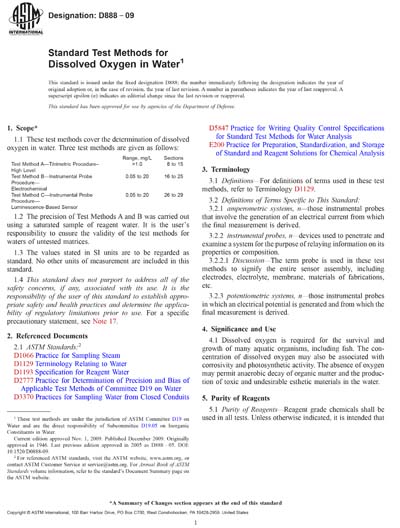Historical
ASTM D888-09
Standard Test Methods for Dissolved Oxygen in Water
1.1 These test methods cover the determination of dissolved oxygen in water. Three test methods are given as follows:
| Range, mg/L | Sections | |
| Test Method A—Titrimetric Procedure– High Level | >1.0 | 8 to 15 |
| Test Method B—Instrumental Probe Procedure— Electrochemical | 0.05 to 20 | 16 to 25 |
| Test Method C—Instrumental Probe Procedure— Luminescence-Based Sensor | 0.05 to 20 | 26 to 29 |
1.2 The precision of Test Methods A and B was carried out using a saturated sample of reagent water. It is the user's responsibility to ensure the validity of the test methods for waters of untested matrices.
1.3 The values stated in SI units are to be regarded as standard. No other units of measurement are included in this standard.
1.4 This standard does not purport to address all of the safety concerns, if any, associated with its use. It is the responsibility of the user of this standard to establish appropriate safety and health practices and determine the applicability of regulatory limitations prior to use. For a specific precautionary statement, see Note 17. 8.1 This test method is applicable to waters containing more than 1000 μg/L of dissolved oxygen such as stream and sewage samples. It is the user's responsibility to ensure the validity of the test method for waters of untested matrices. 8.2 This test method, with the appropriate agent, is usable with a wide variety of interferences. It is a combination of the Winkler Method, the Alsterberg (Azide) Procedure, the Rideal-Stewart (permanganate) modification, and the Pomeroy-Kirshman-Alsterberg modification. 8.3 The precision of the test method was carried out using a saturated sample of reagent water. 16.1 This test method is applicable to waters containing dissolved oxygen in the range from 50 to 20 000 μg/L. It is the user's responsibility to ensure the validity of this test method for waters of untested matrices. 16.2 This test method describes procedures that utilize electrochemical probes for the determination of dissolved oxygen in fresh water and in brackish and marine waters that may contain dissolved or suspended solids. Samples can be analyzed in situ in bodies of water or in streams, or samples can be collected and analyzed subsequent to collection. The electrochemical probe method is especially useful in the monitoring of water systems in which it is desired to obtain a continuous record of the dissolved oxygen content. 16.2.1 This test method is recommended for measuring dissolved oxygen in waters containing materials that interfere with the chemical methods, such as sulfite, thiosulfate, polythionate, mercaptans, oxidizing metal ions, hypochlorite, and organic substances readily hydrolyzable in alkaline solutions. 16.3 Electrochemical dissolved oxygen probes are practical for the continuous monitoring of dissolved oxygen content in natural waters, process streams, biological processes, etc., when the probe output is conditioned by a suitably stable electronic circuit and recorded. The probe must be standardized before use on samples free of interfering materials, preferably with the azide modification of Test Method A. 26.1 This test method is applicable to waters containing dissolved oxygen in the range from 50 to 20 000 g/L. It is the user’s responsibility to ensure the validity of this test method for waters of untested matrices. 26.2 This method is for an instrumental probe-luminescence-based sensor using the technology of frequency-domain lifetime-based luminescence quenching and signal processing for analysis of dissolved oxygen. This method is amenable to all water and wastewater matrices that are free from interferences at normal water and influent-to-treatment and final effluent wastewater concentrations. 26.3 Sustained periods of sensor immersion in water containing high levels of chlorine dioxide may degrade sensor performance. Refer to manufacturer’s guidelines for specific instrument interferences. 26.4 Intrumental probeluminescence-based sensors for dissolved oxygen are practical for the continuous monitoring of dissolved oxygen content in natural water, process streams and biological processes, etc.
ASTM International [astm]

